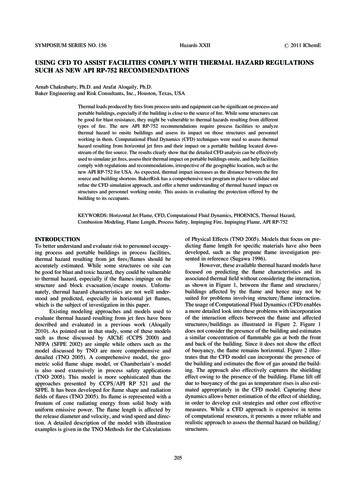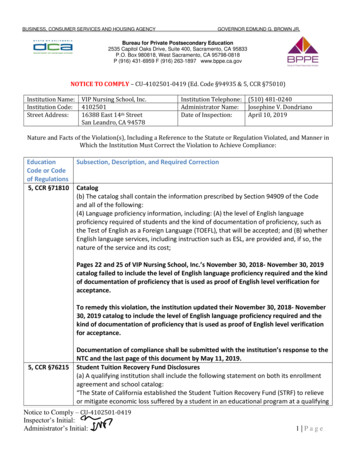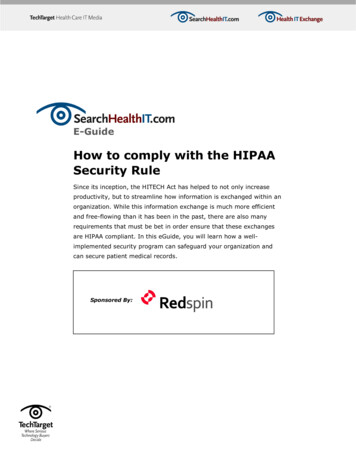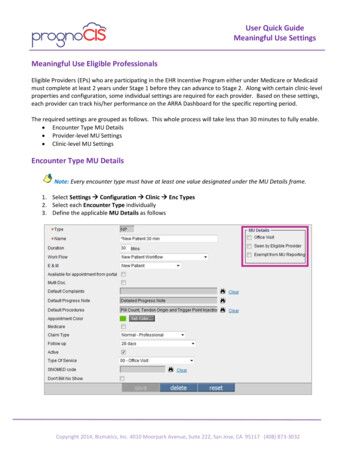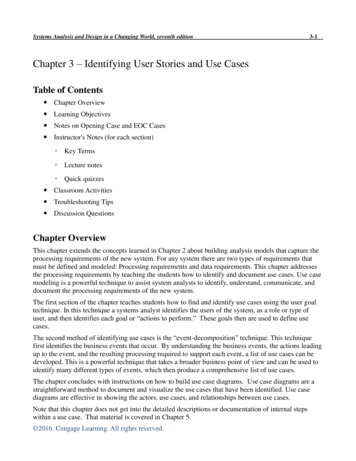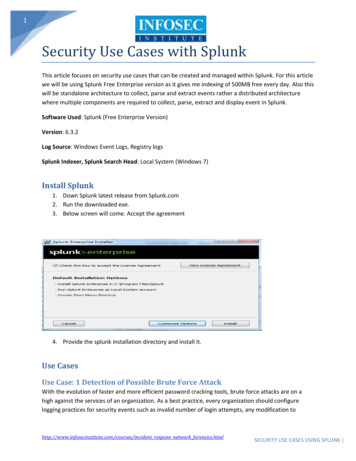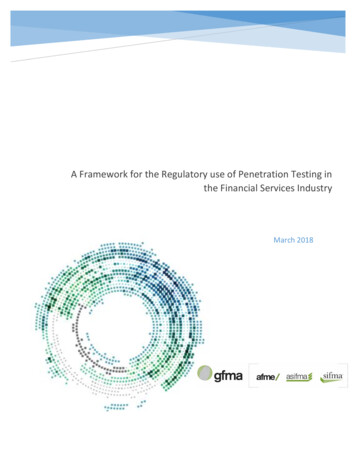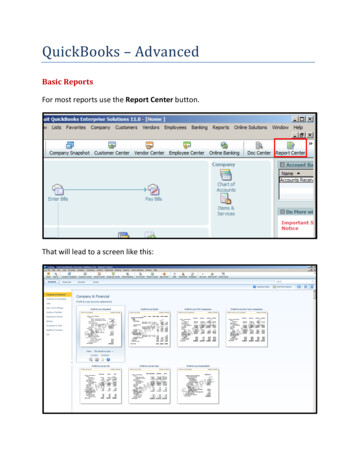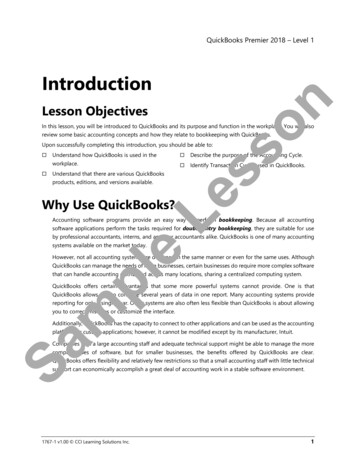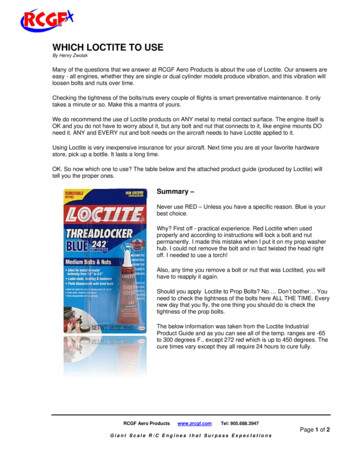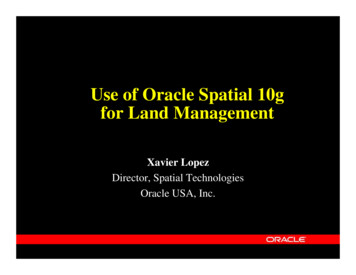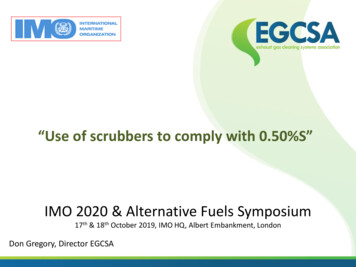
Transcription
“Use of scrubbers to comply with 0.50%S”IMO 2020 & Alternative Fuels Symposium17th & 18th October 2019, IMO HQ, Albert Embankment, LondonDon Gregory, Director EGCSA
Topics 2020 Routes to Compliance & BenefitsScrubber FactsWash water Environmental Impact AssessmentEGCS & Future Maritime Air Quality Ambitions
Background & Membership Inaugurated in 2008Represents 90% of EGCS suppliers globallyAssociate membership of sub suppliersShare knowledge on the health environmental, technical &commercial realities of EGCS technologiesAssure Ethical Compliance Code of Conduct of the EGCS Association
Benefits of 2020 complianceUSE OF 0.50%S FUELS Reduced emissions of SOx – Some 24Mt/annum (2.7%S - 250Mt HSFO)Reduction in secondary particulates – Sulphate formed post stack in theatmosphereReduction in acid rainLowers contribution lung & cardiovascular diseaseUSE OF EXHAUST GAS CLEANING SYSTEMS Exceeds the regulatory SOx reductions ambitions – DFDS example
Benefits of 2020 complianceUSE OF 0.50%S FUELS Reduced emissions of SOx – Some 24Mt/annum (2.7%S - 250Mt HSFO)Reduction in secondary particulates – Sulphate formed post stack in theatmosphereReduction in acid rainLowers contribution lung & cardiovascular diseaseUSE OF EXHAUST GAS CLEANING SYSTEMS Exceeds the regulatory SOx reductions ambitions – DFDS exampleLower human health impact versus distillate & compliant fuel blends
Health Benefits Health effects include lung and cardiovascular disease“Particulate Matter from Both Heavy Fuel Oil and Diesel Fuel ShippingEmissions Show Strong Biological Effects on Human Lung Cells at Realisticand Comparable In Vitro Exposure Conditions”Ship engine emissions are important with regard to lung and cardiovascular diseases especiallyin coastal regions worldwide. Known cellular responses to combustion particles include oxidative stress and inflammatory signalling. Toprovide a molecular link between the chemical and physical characteristics of ship emission particles and the cellular responses they elicit and to identifypotentially harmful fractions in shipping emission aerosols. Through an air-liquid interface exposure system, weexposed human lung cellsunder realistic in vitro conditions to exhaust fumes from a ship engine running on either common heavy fueloil (HFO) or cleaner-burning diesel fuel (DF). Advanced chemical analyses of the exhaust aerosols were combined with transcriptional,proteomic and metabolomic profiling including isotope labelling methods to characterise the lung cell responses. The HFO emissions contained highconcentrations of toxic compounds such as metals and polycyclic aromatic hydrocarbon, and were higher in particle mass. These compounds were lower inDF emissions, which in turn had higher concentrations of elemental carbon ("soot"). Common cellular reactions included cellular stress responses andendocytosis. Reactionsto HFO emissions were dominated by oxidative stress and inflammatoryresponses, whereas DF emissions induced generally a broader biological response than HFOemissions and affected essential cellular pathways such as energy metabolism, proteinsynthesis, and chromatin modification. Despite a lower content of known toxic compounds, combustion particles from the cleanshipping fuel DF influencedseveral essential pathways of lung cell metabolism more strongly than particles fromthe unrefined fuel HFO. This might be attributable to a higher soot content in DF. Thus the role of diesel soot, which is a known carcinogen inacute air pollution-induced health effects should be further investigated. For the use of HFO and DF we recommend a reduction of carbonaceous soot in theship emissions by implementation of filtration devices.
Benefits of 2020 complianceUSE OF 0.50%S FUELS Reduced emissions of SOx – Some 24Mt/annum (2.7%S - 250Mt HSFO)Reduction in secondary particulates – Sulphate formed post stack in theatmosphereReduction in acid rainLowers contribution lung & cardiovascular diseaseUSE OF EXHAUST GAS CLEANING SYSTEMS Exceeds the regulatory SOx reductions ambitions – DFDS exampleLower human health impact versus distillate & compliant fuel blendsLower well to wake CO2 emissions – Concawe energy assessment
Refinery CO2 emissions“The production of fuels with lower Sulphur willlead to increased CO2 emissions from therefining industry. Making use of on-boardscrubbers will result in lower overall CO2emission versus desulphurisation of fuels inrefineries”Page IV, Concawe Report No 1/18
Benefits of 2020 complianceUSE OF 0.50%S FUELS Reduced emissions of SOx – Some 24Mt/annum (2.7%S - 250Mt HSFO)Reduction in secondary particulates – Sulphate formed post stack in theatmosphereReduction in acid rainLowers contribution lung & cardiovascular diseaseUSE OF EXHAUST GAS CLEANING SYSTEMS Exceeds the regulatory SOx reductions ambitions – DFDS exampleLower human health impact versus distillate & compliant fuel blendsLower well to wake CO2 emissions – Concawe energy assessmentContributed to fuel availability study avoiding delay to 2025
Courtesy of Wartsila The number of ships with EGCS installed will exceed 4,000 during 2020Ships installing EGCS have large installed power and/or operate at full powerThese ships represents about 7% of the global fleetBut represent 15% of global fleet annual fuel consumptionScrubber installed vessels are unlikely to be involved in compliance avoidance
Benefits of 2020 complianceUSE OF 0.50%S FUELS Reduced emissions of SOx – Some 24Mt/annum (2.7%S - 250Mt HSFO)Reduction in secondary particulates – Sulphate formed post stack in theatmosphereReduction in acid rainLowers contribution lung & cardiovascular diseaseUSE OF EXHAUST GAS CLEANING SYSTEMS Exceeds the regulatory SOx reductions ambitions – DFDS exampleLower human health impact versus distillate & compliant fuel blendsLower well to wake CO2 emissions – Concawe energy assessmentContributed to fuel availability study avoiding delay to 2025Scheme B requires continuous performance monitoring & recording of compliance
Historical use of scrubbersLAND BASED SYSTEMS Globally since the 1960s over 30 power stations and refineries have adopted sea waterscrubbing to remove SO2 and other emissions–––––One of the earliest applications of scrubbing – Battersea Power Station on the river ThamesPeriodic inspections over up to 40 years have not identified significant short or long term affectsTotal installed power scrubbed has exceeded 100GWCountries include China, Norway, UK, Malaysia, USA The current fleet with installed scrubbers is estimated to be around 80GW (but operated at 50% power)TANKER INERT GAS SYSTEMS Following several explosions inert gas systems were widely adopted in the 1970s.Crude oil tankers scrubbers clean the exhaust gases from steam boilers prior to use asa blanket of inert gas in the headspace above the crude oilPort of Rotterdam is the main sea borne import location for northern Europe. Despiteinert gas scrubbing over the 24/365 for the last 60 years there is no detectableevidence of any impact on sediments in the discharge locations
EGCS – DefinitionsOPEN LOOP SCRUBBER Utilises the natural alkalinity of sea water to neutralise acid formed fromscrubbing SO2. The wash water is appropriately processed before returning tothe sea in accordance with IMO discharge limitsCLOSED LOOP SCRUBBER Utilises an alkali reagent such as Caustic Soda or Magnesium Hydroxide toneutralise acid formed from scrubbing SO2. Typically the wash water flow rate islower than open loop scrubbers as the reagent provides a more concentratedalkalinity. The circulated wash water is treated to ensure that the 0.5% bleed-offwater returned to the sea is in accordance with IMO discharge limits. For shortperiods the bleed-off can be stored on board if a suitable holding tank is installedHYBRID SCRUBBER Can operate as an Open Loop or Closed Loop scrubber
Wash Water EIADISCHARGES TO WATER 1991 M/S Kronprins Harald serving the Oslo - Kiel route. Environment impactconsidered the marine organism exposure time negligible considering very lowconcentrationBP Marine study published in March 2005–––– Danish EPA study in 2012––– Literature review of discharges to marine environmentComponent analysisBio assaysMAM PEC modelEvaluated wash water samples from scrubber in service in North EuropeDetailed chemical analysisOverall impact of the measured discharge applied to shipping density scenarioJapanese study published February 2019–––Shore-side engine & scrubber installation utilising sea water from Tokyo BayDetailed analysis of wash waterConcluded discharge well below levels considered harmful
Wash Water EIA cont’dDISCHARGES TO WATER Numerous discharge water sampling studies––––– EGCSA 22 ships in northern EuropeCarnival Cruise 80 vessels throughout fleetScientific study on 5 ships funded by German Environment AgencyUS EPA General Vessel Permit discharge analysis submissionsShip-owner discharge water analysis submissions to Flag StateStrict discharge limits which are monitored & continuously recorded on all wetscrubber systems
EGCS – The Future With the current known technology it is unlikely that heat engines will bedisplaced for main propulsion in the next 20 yearsAlternative fuels may provide the targeted zero GHG emissions for newbuildings launched in 2030All alternative fuels have emissions and may need exhaust gas cleaningReducing or elimination Black Carbon emission will require exhaust gasaftertreatmentFuture emissions regulations will almost certainly include ultra-fine particulateScrubbers are evolving to assist in meeting Tier III NOx emissions
THANK-YOUFor a wealth of materials on EGCS please visit our website atwww.egcsa.com
Benefits of 2020 compliance USE OF 0.50%S FUELS Reduced emissions of SOx –Some 24Mt/annum (2.7%S - 250Mt HSFO) Reduction in secondary particulates –Sulphate formed post stack in the atmosphere Reduction in acid rain Lowers contribution lung & c
